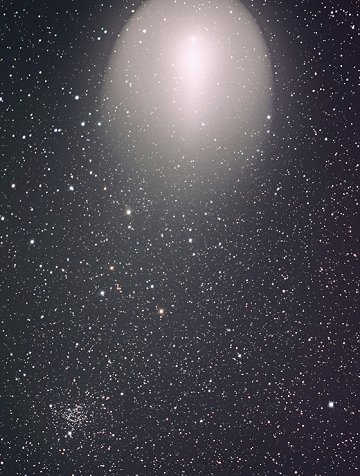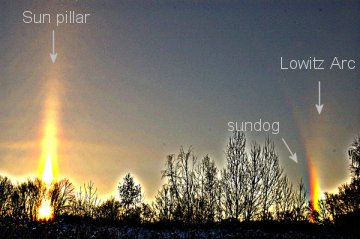 Where's Saturn? Is that a UFO--or the ISS? What's the name of that star? Get the answers from mySKY--a fun new astronomy helper from Meade. Where's Saturn? Is that a UFO--or the ISS? What's the name of that star? Get the answers from mySKY--a fun new astronomy helper from Meade. EASY COME, EASY GO: This morning, a new bipolar sunspot emerged in the sun's eastern hemisphere and now, just hours later, it is already decaying: movie. If you have a solar telescope, this may be a good opportunity to watch a planet-sized object disintegrate before your very eyes. COMET 17P/HOLMES: "The 'Jellyfish Comet' has caught some small fish," reports Paolo Candy who took this picture last night from the Cimini Astronomical Observatory in Soriano, Italy: 
The "fish" are the stars of open cluster NGC 1245 located downstream of Holmes' developing tail. NGC 1245 is a swarm of hundreds, perhaps thousands, of stars 800 light years from Earth. It shows up nicely in 10+ minute exposures of the comet through amateur telescopes. Comet 17P/Holmes is no longer the bright naked-eye object it was when it first exploded in late October. But it remains an easy target for binoculars, night vision goggles and backyard telescopes. After sunset, point your optics at the constellation Perseus and scan around for the Jellyfish: sky map. It's easy! Comet 17P/Holmes Photo Gallery
[Interactive World Map of Comet Photos]
[sky map] [ephemeris] [3D orbit] [Night Sky Cameras] LOWITZ ARCS! On Nov. 23rd, Lori C. of King City, Canada, went outside at sunrise--"the temperature was minus 9 degrees with snowy crystals in the air," she says--and photographed what at first appeared to be a garden-variety ice halo: photo. Closer inspection, however, reveals something rare and extraordinary: "Lori captured the fabled Lowitz arc," says atmospheric optics expert Les Cowley. 
"The 'garden variety' arcs in Lori's photo are a sun pillar flanked by two sundogs. Look carefully at the sundogs and you will see the extremely rare Lowitz arcs curving upwards and outwards away from the sun," he points out. "Tobias Lowitz first sketched them in St Petersburg over 200 years ago and controversy has raged over their very existence ever since. They were first photographed in the 1990s but they are still a hot topic of debate. Lori’s arcs are ungerade-Lowitz arcs, ungerade because sunlight had an odd number of reflections inside the Lowitz ice crystals. Next time you see bright sundogs look carefully, Lowitz arcs could be lurking there too!" | 
